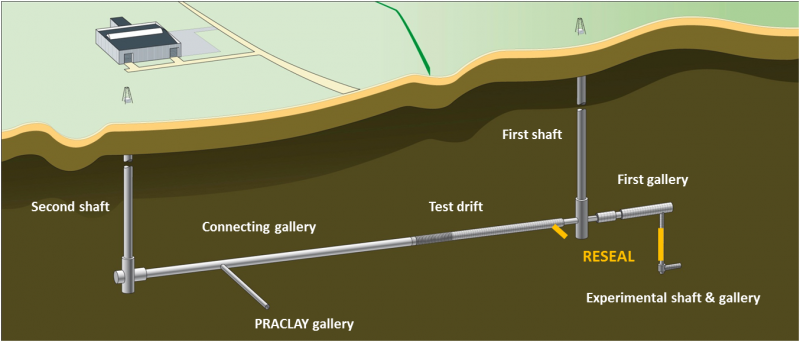RESEAL (1997-2009)
 |
A large-scale in-situ demonstration test for repository sealing in an argillaceous host rock
The construction of the HADES laboratory is important in order to be able to study and demonstrate the technical feasibility of geological disposal in poorly indurated clay formations like the Boom Clay. The current design by ONDRAF/NIRAS of the repository for geological disposal of category B & C waste consists of vertical shafts that give access to a network of horizontal galleries for transport and disposal of the waste packages.
One of the challenges for long-term safety is backfilling and sealing shafts and galleries. This is needed to avoid preferential pathways for water, gas and radionuclide migration. The demonstration of the feasibility of sealing on a representative scale is therefore essential. The applicability of highly compacted bentonite for this purpose has been investigated. The low permeability, swelling capacity and high sorption capacity of bentonite make it a very effective barrier.
OBJECTIVES
The RESEAL project started with a first phase in 1996 within the 4th Framework Programme of the European Commission. The main objectives of this first phase were to design, install and hydrate a borehole and a shaft sealing experiment and to obtain basic parameters on the hydro-mechanical behaviour of the sealing materials.
The RESEAL project was continued with a second phase within the 5th Framework Programme of the European Commission, which started in 2001. The main objectives were to increase knowledge about the hydro-mechanical behaviour of the sealing material used in the shaft seal, evaluate the hydro-mechanical interaction of the shaft seal with the surrounding host rock and further evaluate the performance of the borehole seal and the shaft seal with respect to water, gas and radionuclide migration on the basis of the in-situ test results and numerical simulations.
The experiments were also evaluated from the performance assessment (PA) point of view.
OUTCOME
The results of the RESEAL project show that it is technically feasible to seal boreholes and shafts in argillaceous media with bentonite products. Pre-compacted bentonite blocks or a mixture of bentonite pellets and powder can be used.
For the borehole seal experiment, the hydraulic conductivity of the seal measured in situ is consistent with the predicted values based on laboratory measurements, and is one order of magnitude lower than the intact Boom Clay (order of magnitude of 10-13 m/s). The gas breakthrough experiment clearly showed that no preferential gas flow through the seal occurs. With the set-up used, it is not possible to determine whether gas flow occurred through the excavation-damaged zone (EDZ) of the host rock or through the host rock/seal interface. Concerning radionuclide migration through the seal, comparison of observed concentrations with modelling results does not yield any evidence of the presence of preferential pathways within or around the seal.
For the shaft seal experiment, it takes longer than originally expected to reach full saturation of the seal and artificial hydration only has a limited effect on the time needed to reach a fully or almost fully saturated state. Thanks to visual observations and pore water pressure measurements through the piezometer filters installed inside the host rock, it could clearly be demonstrated that fractures are created or re-created during removal of the concrete lining. These fractures are limited to a cylindrical zone around the sealed part and extend up to at least one metre inside the surrounding host rock. The evolution of pore water pressure inside the host rock clearly shows that self-healing is a slow, progressive process starting in the host rock and evolving towards the host rock/lining interface. Moreover, hydraulic conductivity measurements of the host rock in the course of 2005 and 2006 yielded values in line with those reported in the literature, i.e. of the same order of magnitude as undisturbed Boom Clay indicating that the seal is performing well. The results also reflect the known anisotropy of hydraulic conductivity in the Boom Clay (KH = ~2.Kv). Hydraulic conductivities measured inside the seal are of the expected order of magnitude. Gas injection tests did not show any clear connection between filters inside the seal, but the breakthrough pressure seems to be higher than the measured total pressure inside the seal. Finally, the radionuclide migration tests in the EDZ suggested that no preferential pathways for radionuclide migration exist.
SUMMARY (.pdf)
REFERENCE PUBLICATIONS
Volckaert, G., Dereeper, B., Put, M., Ortiz, L., Gens, A., Vaunat, J., Villar, M.V., Martin, P.L., Imbert, C., Lassabatère, R., Mouche, E. and Cany, F., 2000. A large scale in situ demonstration test for repository sealing in an argillaceous host rock. RESEAL project - Phase I. European Commission, Luxembourg, EUR 19612, 273pp.
Van Geet, M., Bastiaens, W., Volckaert, G., Weetjens, E., Sillen, X., Maes, N., Imbert, Ch., Billaud, P., Touzé, G., Filippi, M., Plas, F., Villar, M.V., García-Gutiérrez, M., Mingarro, M., Gens, A., Vallejan, B., 2009. RESEAL II: A large-scale in situ demonstration test for repository sealing in an argillaceous host rock – Phase II. European Commission, Luxembourg, EUR 24161, 278pp.
